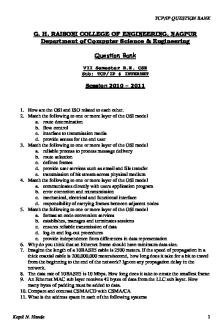TCP Connection Management PDF

| Title | TCP Connection Management |
|---|---|
| Course | Computer Networks |
| Institution | University of Greenwich |
| Pages | 3 |
| File Size | 148 KB |
| File Type | |
| Total Downloads | 91 |
| Total Views | 131 |
Summary
Download TCP Connection Management PDF
Description
TCP Connection Management TCP has 3 phases 1) Connection Establishment phase 2) Data transmission phase 3) Connection Termination phase Connection establishment phase:
Step 1: The client-side TCP first sends a special TCP segment to the server-side TCP. This special segment contains no application-layer data. But one of the flag bits in the segment’s header, the SYN bit, is set to 1. For this reason, this special segment is referred to as a SYN segment. In addition, the client randomly chooses an initial sequence number (client_isn) and puts this number in the sequence number field of the initial TCP SYN segment.
Step 2: Once the IP datagram containing the TCP SYN segment arrives at the server host the server extracts the TCP SYN segment from the datagram, allocates the TCP buffers and variables to the connection, and sends a connection-granted segment to the client TCP. This connection-granted segment also contains no application layer data.
However, it does contain three important pieces of information in the segment header. First, the SYN bit is set to 1. Second, the acknowledgment field of the TCP segment header is set to client_isn+1. Finally, the server chooses its own initial sequence number (server_isn) and puts this value in the sequence number field of the TCP segment header. This is referred as SYNACK segment.
Step 3: Upon receiving the SYNACK segment, the client also allocates buffers and variables to the connection. The client host then sends the server yet another
segment; this last segment acknowledges the server’s connection-granted segment. The SYN bit is set to zero, since the connection is established. This third stage of the three-way handshake may carry client-to-server data in the segment payload.
Connection Termination phase: Either of the two processes participating in a TCP connection can end the connection. When a connection ends, the “resources” (that is, the buffers and variables) in the hosts are deallocated. For connection termination TCP sends segment with FIN flag set to 1.
When the server receives this segment, it sends the client an acknowledgment segment in return. The server then sends its own shutdown segment, which has the FIN bit set to 1. Finally, the client acknowledges the server’s shutdown segment. At this point, all the resources in the two hosts are now deallocated.
State transition diagram: Client
Server:...
Similar Free PDFs

TCP Connection Management
- 3 Pages

Lab4b TCP - TCP lab material
- 6 Pages

Wireshark TCP
- 11 Pages

5 - CONNECTION
- 6 Pages

Fresh Connection Tips
- 2 Pages

Importance of Social Connection
- 1 Pages

Connection to real life
- 1 Pages

Remote PC Connection
- 2 Pages

Tcp-ip-question-bank
- 25 Pages

TCP Lab Assessment
- 8 Pages

Práctica Comandos TCP/IP
- 33 Pages

Connection vs Connectionless
- 4 Pages

TCP Attack - assignmetns
- 13 Pages

RAM Connection Standalone V8i
- 114 Pages
Popular Institutions
- Tinajero National High School - Annex
- Politeknik Caltex Riau
- Yokohama City University
- SGT University
- University of Al-Qadisiyah
- Divine Word College of Vigan
- Techniek College Rotterdam
- Universidade de Santiago
- Universiti Teknologi MARA Cawangan Johor Kampus Pasir Gudang
- Poltekkes Kemenkes Yogyakarta
- Baguio City National High School
- Colegio san marcos
- preparatoria uno
- Centro de Bachillerato Tecnológico Industrial y de Servicios No. 107
- Dalian Maritime University
- Quang Trung Secondary School
- Colegio Tecnológico en Informática
- Corporación Regional de Educación Superior
- Grupo CEDVA
- Dar Al Uloom University
- Centro de Estudios Preuniversitarios de la Universidad Nacional de Ingeniería
- 上智大学
- Aakash International School, Nuna Majara
- San Felipe Neri Catholic School
- Kang Chiao International School - New Taipei City
- Misamis Occidental National High School
- Institución Educativa Escuela Normal Juan Ladrilleros
- Kolehiyo ng Pantukan
- Batanes State College
- Instituto Continental
- Sekolah Menengah Kejuruan Kesehatan Kaltara (Tarakan)
- Colegio de La Inmaculada Concepcion - Cebu

